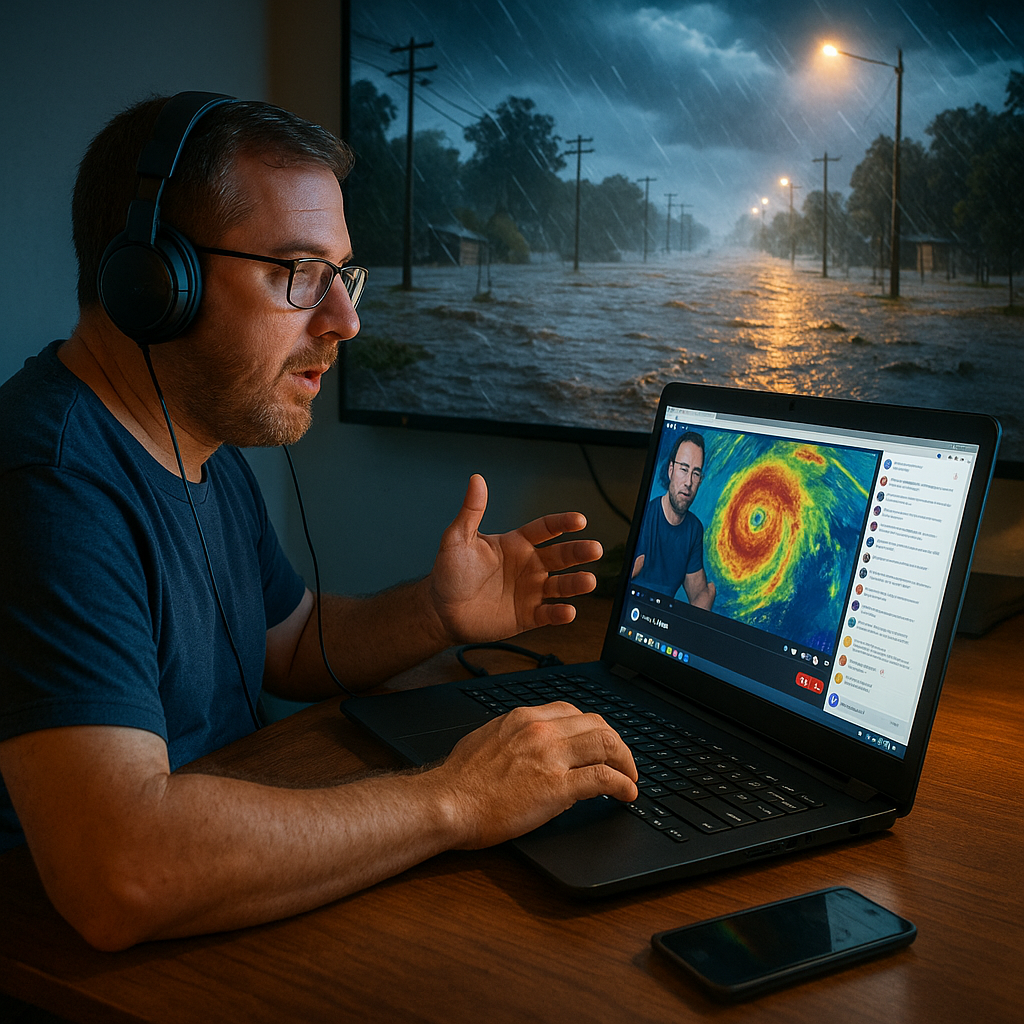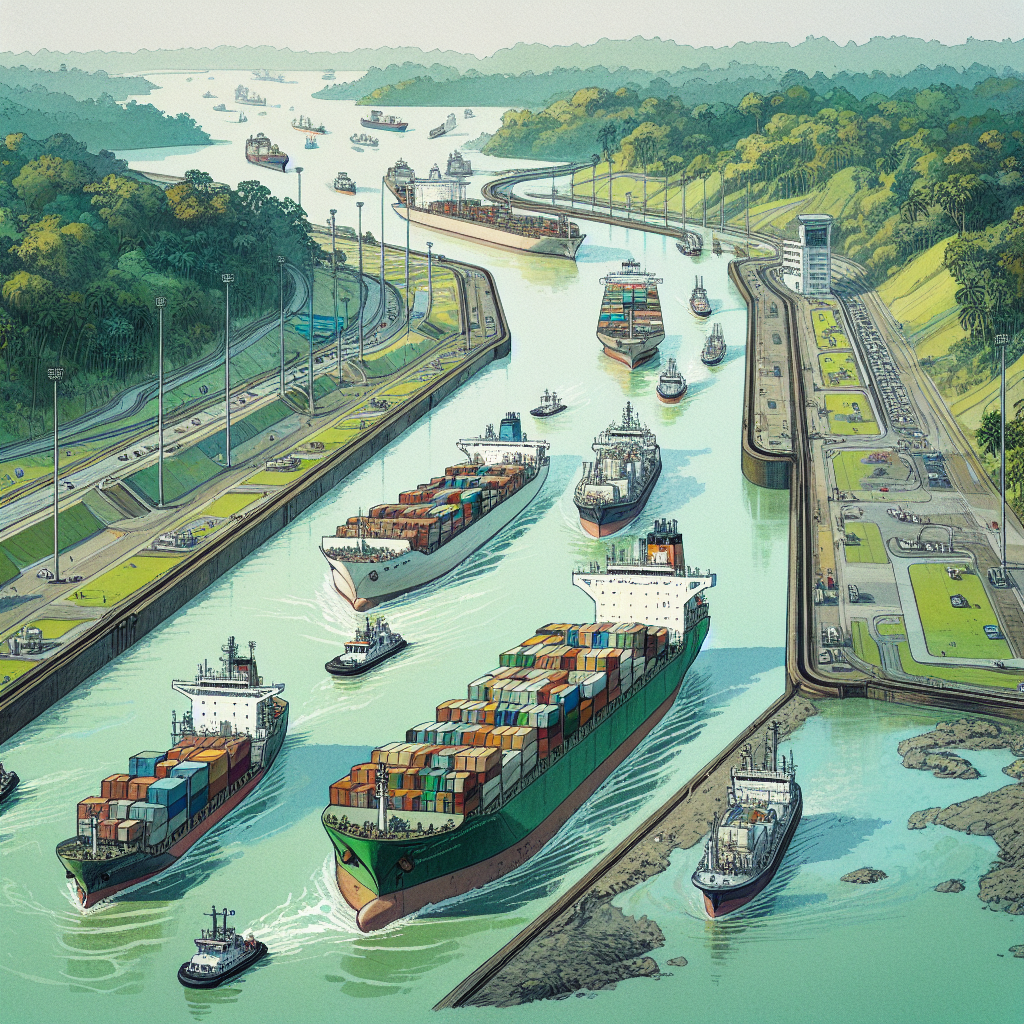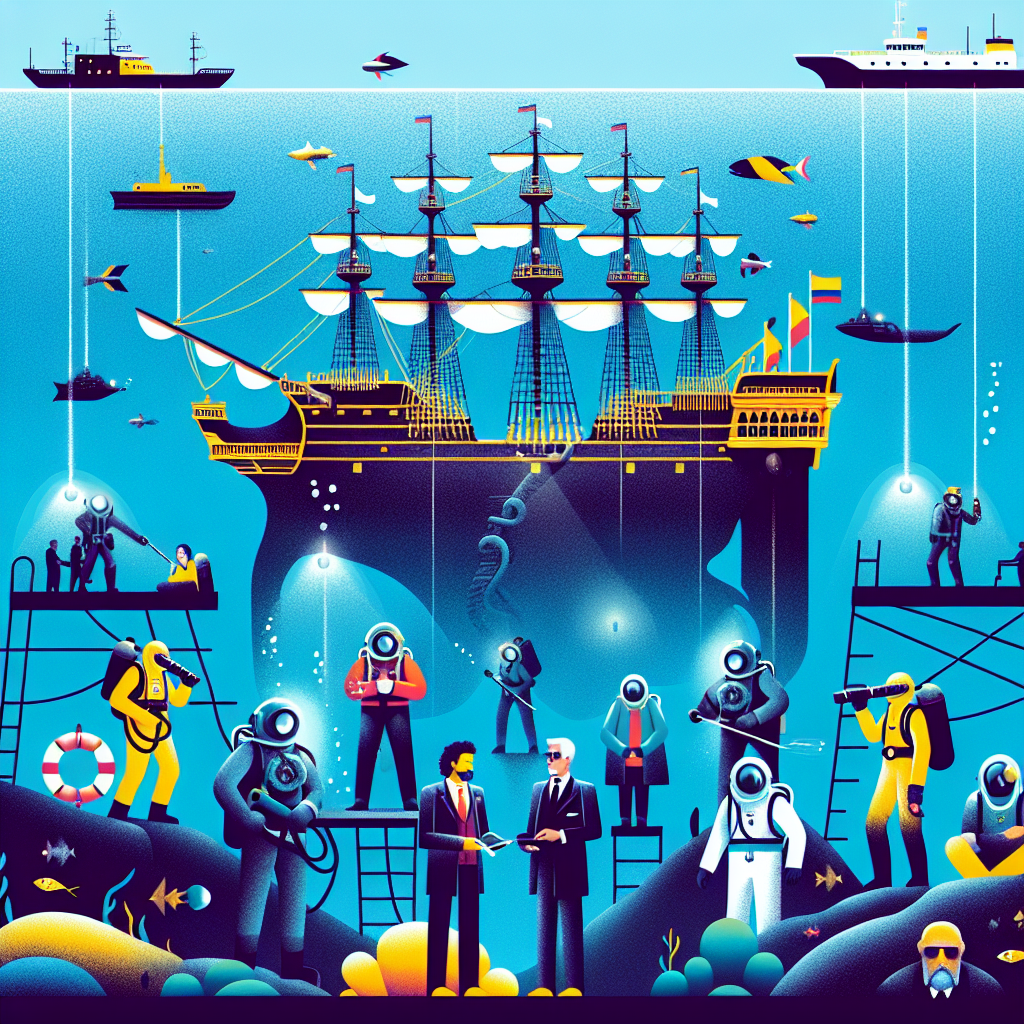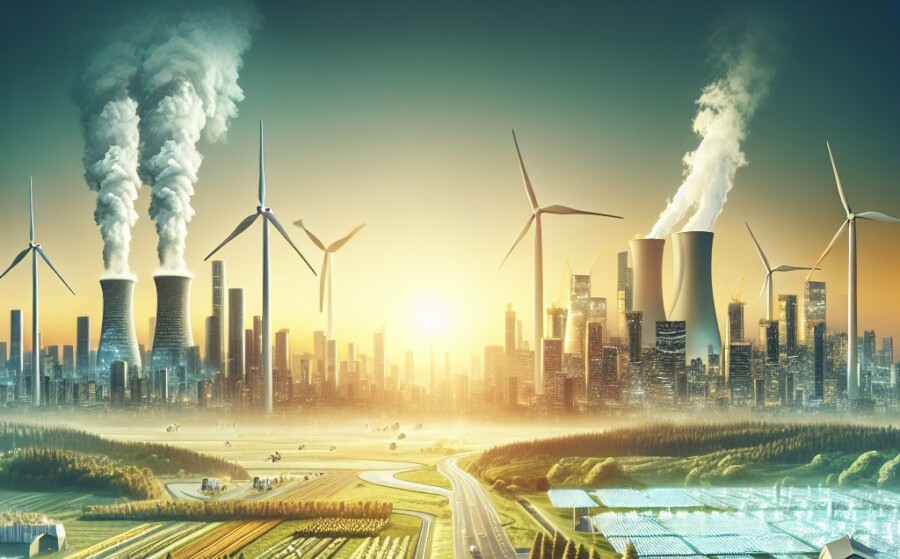In recent months, many residents of North Queensland, Australia, have faced significant challenges due to extreme weather conditions, including severe flooding. Among those affected is Andrew Brown, a cybersecurity lecturer who has gained recognition as an amateur weather forecaster through his Facebook page, Wally’s Weather. With over 107,000 followers and 24 million monthly views, Brown has become a vital source of weather updates for his community, especially during the record-breaking floods that forced hundreds to evacuate their homes. His commitment to providing timely information has led him to post updates around the clock, even during the night, to ensure that his audience is well-informed.
The rise of weather influencers like Brown reflects a broader trend in which the public increasingly turns to social media for news and weather information. According to research from the Pew Research Centre, approximately 20% of adults in the United States rely on social media for such updates. This shift indicates that many people trust influencers as much as, or even more than, traditional journalists. Prof. Daniel Angus, director of the Digital Media Research Centre at Queensland University of Technology, notes that weather influencers often provide localized, real-time updates that mainstream media may overlook, particularly in rural areas. Their direct engagement with the audience fosters a sense of community and relatability that traditional news outlets may lack.
However, the popularity of weather influencers is not without its drawbacks. Prof. Angus points out that some influencers have been criticized for sensationalizing weather events, which can lead to misinformation and public panic. For instance, Higgins Storm Chasing, another weather influencer, faced backlash for making exaggerated predictions about rainfall and flooding in 2018 that did not materialize. Unlike official meteorological organizations, these influencers are not held to the same standards, which raises concerns about accountability and the potential for scaremongering.
Experts like Alan Sealls, a former TV weatherman and current meteorology professor, emphasize the importance of trained meteorologists in providing accurate forecasts. While some weather influencers possess the knowledge and equipment to deliver reliable updates during crises, others may lack formal training and contribute to confusion by promoting long-range forecasts that are inherently uncertain. Sealls argues that trained professionals are better equipped to avoid misleading the public, especially when discussing extreme weather events.
Despite the challenges, the world of weather influencing offers opportunities for individuals like Andrew Brown to monetize their expertise. While Brown has invested significantly in forecasting equipment and has introduced paid subscriptions to cover costs, he remains focused on providing valuable information to his community. Similarly, other influencers, such as Andrew Markowitz, have found ways to earn income through sponsorships and donations while maintaining their primary jobs. As the landscape of weather forecasting continues to evolve, the balance between traditional meteorological expertise and the rise of social media influencers will remain a topic of discussion among experts and the public alike.
Original news source: Who should you trust for a weather forecast? (BBC)
🎧 Listen:
Slow
Normal
Fast
📖 Vocabulary:
| 1 | cybersecurity | The practice of protecting systems, networks, and programs from digital attacks |
| 2 | recognition | Acknowledgment or appreciation of someone’s achievements or status |
| 3 | evacuate | To leave a place, especially in an emergency, for safety reasons |
| 4 | commitment | A dedication or obligation to a cause or activity |
| 5 | mainstream | The dominant or widely accepted group or trend in a particular field |
| 6 | engagement | The act of being involved or participating in something |
| 7 | sensationalizing | Presenting information in a way that provokes excitement or shock, often at the expense of accuracy |
| 8 | misinformation | False or misleading information spread regardless of intent |
| 9 | accountability | The state of being responsible or answerable for something |
| 10 | scaremongering | The act of spreading fear or alarm, especially unnecessarily |
| 11 | inherently | Existing as a natural or essential characteristic |
| 12 | monetize | To earn money from something, typically a skill or service |
| 13 | expertise | Specialized knowledge or skills in a particular area |
| 14 | sponsorships | Financial support received from a company or organization in exchange for promoting their products or services |
| 15 | landscape | The overall environment or setting in which a particular activity or process occurs |
Group or Classroom Activities
Warm-up Activities:
– CHARADES
Instructions: Divide the class into small groups. Each group will take turns acting out terms related to the article (e.g., flooding, influencer, weather forecast) without speaking, while the other groups guess the word or phrase.
– OPINION POLL
Instructions: Have students discuss their opinions on the impact of social media influencers in news reporting. Create a list of questions (e.g., “Do you trust weather influencers more than traditional meteorologists?”) and conduct a class poll. Afterward, discuss the results as a class.
– MIND MAP
Instructions: In small groups, have students create a mind map on the topic of “Weather Influencers.” They should include branches for pros, cons, public perception, and examples. Afterward, each group can present their mind map to the class.
– HEADLINE CREATION
Instructions: Ask students to create catchy headlines for the article, focusing on its main points. After they brainstorm individually, students can share their headlines in pairs, discussing which one they think best captures the essence of the article.
– TWO TRUTHS AND A LIE
Instructions: Each student will come up with two true statements and one false statement inspired by the article’s content regarding weather influencers and their impact. They will share these with a partner, who must identify which statement is the lie. Afterward, partners can switch and share with another pair.
🤔 Comprehension Questions:
1. Who is Andrew Brown and what role has he taken on in his community during the recent flooding in North Queensland?
2. How has Andrew Brown’s Facebook page, Wally’s Weather, impacted the way residents receive weather updates?
3. What trend does the article highlight regarding the public’s reliance on social media for news and weather information?
4. According to Prof. Daniel Angus, what advantages do weather influencers have over traditional news outlets?
5. What concerns are raised about the potential drawbacks of weather influencers, as mentioned by Prof. Angus?
6. How do experts like Alan Sealls view the role of trained meteorologists in comparison to weather influencers?
7. In what ways have weather influencers like Andrew Brown found opportunities to monetize their expertise?
8. What ongoing discussion does the article suggest will occur regarding the relationship between traditional meteorological expertise and social media influencers?
Go to answers ⇩
🎧✍️ Listen and Fill in the Gaps:
In recent months, many residents of North Queensland, Australia, have faced significant challenges due to extreme weather conditions, including severe flooding. Among those affected is Andrew Brown, a (1)______ lecturer who has gained recognition as an amateur weather forecaster through his Facebook page, Wally’s Weather. With over 107,000 followers and 24 million monthly (2)______, Brown has become a (3)______ source of weather updates for his community, especially during the record-breaking floods that forced hundreds to evacuate their homes. His commitment to providing timely information has led him to post updates around the clock, even during the night, to ensure that his audience is well-informed.
The rise of weather influencers like Brown reflects a broader trend in which the public increasingly turns to (4)______ media for news and (5)______ information. According to research from the Pew Research Centre, approximately 20% of (6)______ in the United States rely on social media for such updates. This shift indicates that many people trust influencers as much as, or even more than, traditional journalists. Prof. Daniel (7)______, director of the Digital Media Research Centre at Queensland University of Technology, notes that weather influencers often provide localized, real-time updates that mainstream media may (8)______, particularly in rural areas. Their direct engagement with the audience fosters a sense of community and relatability that traditional news outlets may lack.
However, the popularity of weather influencers is not without its drawbacks. Prof. Angus points out that some influencers have been criticized for sensationalizing weather events, which can lead to misinformation and public panic. For (9)______, (10)______ Storm Chasing, another weather influencer, faced backlash for making exaggerated predictions about rainfall and flooding in 2018 that did not materialize. Unlike official meteorological organizations, these influencers are not held to the same standards, which raises concerns about accountability and the potential for scaremongering.
Experts like Alan Sealls, a former TV weatherman and current meteorology (11)______, emphasize the importance of trained meteorologists in providing accurate forecasts. While some weather influencers possess the knowledge and equipment to deliver reliable updates during crises, others may lack (12)______ training and contribute to confusion by promoting long-range forecasts that are inherently uncertain. Sealls argues that trained professionals are better (13)______ to avoid misleading the public, especially when discussing extreme weather events.
Despite the challenges, the (14)______ of weather influencing offers opportunities for individuals like Andrew Brown to monetize their expertise. While Brown has invested significantly in forecasting equipment and has (15)______ paid subscriptions to cover costs, he remains focused on providing valuable information to his community. Similarly, other influencers, such as Andrew Markowitz, have found ways to earn income through sponsorships and donations while maintaining their primary jobs. As the landscape of weather forecasting continues to (16)______, the balance between traditional meteorological expertise and the rise of social media influencers will remain a topic of discussion among experts and the public alike.
Go to answers ⇩
💬 Discussion Questions:
Students can ask a partner these questions, or discuss them as a group.
1. What is a weather influencer, and how do you think they differ from traditional meteorologists?
2. How would you feel if you had to rely on social media for important weather updates instead of traditional news sources?
3. Do you think social media has changed the way we perceive news and information? Why or why not?
4. What is a significant weather event you have experienced, and how did you stay informed during that time?
5. How do you feel about the idea of influencers providing critical information during emergencies? Do you think they can be trusted?
6. Do you like following social media accounts for weather updates? Why or why not?
7. How would you react if you learned that a weather influencer you trusted had provided inaccurate information?
8. Do you think there should be regulations for weather influencers to ensure the accuracy of their forecasts? Why or why not?
9. What is a potential risk of relying on influencers for weather information, in your opinion?
10. How do you think communities can better support each other during extreme weather events?
11. Do you believe that the engagement and relatability of weather influencers make them more effective than traditional news outlets? Why or why not?
12. How would you feel if you were a trained meteorologist and saw unqualified influencers sharing weather forecasts?
13. Do you think the popularity of weather influencers will continue to grow? Why or why not?
14. What is a way that you think weather influencers can improve their credibility and accountability in the eyes of the public?
15. How do you think the role of technology, such as smartphones and social media, has impacted our understanding of weather events?
Individual Activities
📖💭 Vocabulary Meanings:
Match each word to its meaning.
Words:
1. cybersecurity
2. recognition
3. evacuate
4. commitment
5. mainstream
6. engagement
7. sensationalizing
8. misinformation
9. accountability
10. scaremongering
11. inherently
12. monetize
13. expertise
14. sponsorships
15. landscape
Meanings:
(A) Specialized knowledge or skills in a particular area
(B) The act of spreading fear or alarm, especially unnecessarily
(C) To leave a place, especially in an emergency, for safety reasons
(D) Financial support received from a company or organization in exchange for promoting their products or services
(E) The practice of protecting systems, networks, and programs from digital attacks
(F) Existing as a natural or essential characteristic
(G) The dominant or widely accepted group or trend in a particular field
(H) The state of being responsible or answerable for something
(I) Acknowledgment or appreciation of someone’s achievements or status
(J) The act of being involved or participating in something
(K) The overall environment or setting in which a particular activity or process occurs
(L) False or misleading information spread regardless of intent
(M) A dedication or obligation to a cause or activity
(N) To earn money from something, typically a skill or service
(O) Presenting information in a way that provokes excitement or shock, often at the expense of accuracy
Go to answers ⇩
🔡 Multiple Choice Questions:
1. Who is Andrew Brown?
(a) A professional meteorologist
(b) A cybersecurity lecturer and amateur weather forecaster
(c) A journalist
(d) A politician
2. What social media platform does Andrew Brown use for his weather updates?
(a) Twitter
(b) Instagram
(c) TikTok
(d) Facebook
3. How many followers does Andrew Brown have on his Facebook page, Wally’s Weather?
(a) Over 50,000
(b) Over 200,000
(c) Over 300,000
(d) Over 107,000
4. What percentage of adults in the United States rely on social media for weather updates, according to Pew Research Centre?
(a) Approximately 10%
(b) Approximately 30%
(c) Approximately 20%
(d) Approximately 50%
5. What concern is raised about weather influencers like Andrew Brown?
(a) They may sensationalize weather events
(b) They provide too much information
(c) They are too reliant on traditional media
(d) They have too few followers
6. Who is Prof. Daniel Angus?
(a) Director of the Digital Media Research Centre at Queensland University of Technology
(b) A professional meteorologist
(c) A social media influencer
(d) A journalist
7. What is one way that Andrew Brown has monetized his expertise?
(a) By selling merchandise
(b) By hosting events
(c) By introducing paid subscriptions
(d) By creating a podcast
8. What is emphasized by experts regarding trained meteorologists?
(a) They are less reliable than influencers
(b) They are better equipped to provide accurate forecasts
(c) They focus only on long-range forecasts
(d) They do not engage with the public as much as influencers
Go to answers ⇩
🕵️ True or False Questions:
1. Some weather influencers have been praised for accurately reporting weather events, which can lead to informed decisions and public awareness.
2. Andrew Brown has introduced paid subscriptions to cover the costs of his forecasting equipment while focusing on providing valuable information to his community.
3. Research indicates that approximately 20% of adults in the United States rely on social media for weather updates.
4. Andrew Brown is a cybersecurity expert who has gained recognition as a professional weather forecaster.
5. Brown operates a Facebook page called Andy’s Weather, which has over 107,000 followers and 24 million monthly views.
6. Many residents of North Queensland, Australia, have faced challenges due to extreme weather conditions, including severe flooding.
7. Experts emphasize the importance of diverse sources in providing accurate weather forecasts.
8. The rise of weather influencers reflects a trend where the public increasingly turns to social media for news and weather information.
Go to answers ⇩
📝 Write a Summary:
Write a summary of this news article in two sentences.
Check your writing now with the best free AI for English writing!
Writing Questions:
Answer the following questions. Write as much as you can for each answer.
Check your answers with our free English writing assistant!
1. How has Andrew Brown’s role as a weather influencer impacted his community during extreme weather events?
2. What are some advantages of turning to social media for weather updates compared to traditional news outlets?
3. In what ways can sensationalism by weather influencers lead to negative consequences for the public?
4. Why do experts believe that trained meteorologists are essential in providing accurate weather forecasts?
5. How are weather influencers like Andrew Brown finding ways to monetize their expertise while still serving their communities?
✅ Answers
🤔✅ Comprehension Question Answers:
1. Who is Andrew Brown and what role has he taken on in his community during the recent flooding in North Queensland?
Andrew Brown is a cybersecurity lecturer who has gained recognition as an amateur weather forecaster through his Facebook page, Wally’s Weather. During the recent flooding in North Queensland, he has taken on the role of providing vital weather updates to his community, especially during the record-breaking floods that forced hundreds to evacuate their homes.
2. How has Andrew Brown’s Facebook page, Wally’s Weather, impacted the way residents receive weather updates?
Wally’s Weather has become a vital source of weather updates for residents, with over 107,000 followers and 24 million monthly views. Brown’s commitment to providing timely information has led him to post updates around the clock, ensuring that his audience is well-informed during extreme weather conditions.
3. What trend does the article highlight regarding the public’s reliance on social media for news and weather information?
The article highlights a trend where approximately 20% of adults in the United States rely on social media for news and weather updates, indicating that many people trust influencers as much as, or even more than, traditional journalists.
4. According to Prof. Daniel Angus, what advantages do weather influencers have over traditional news outlets?
Prof. Daniel Angus notes that weather influencers often provide localized, real-time updates that mainstream media may overlook, particularly in rural areas. Their direct engagement with the audience fosters a sense of community and relatability that traditional news outlets may lack.
5. What concerns are raised about the potential drawbacks of weather influencers, as mentioned by Prof. Angus?
Prof. Angus raises concerns that some weather influencers have been criticized for sensationalizing weather events, which can lead to misinformation and public panic. This lack of accountability compared to official meteorological organizations raises issues about the potential for scaremongering.
6. How do experts like Alan Sealls view the role of trained meteorologists in comparison to weather influencers?
Experts like Alan Sealls emphasize the importance of trained meteorologists in providing accurate forecasts. While some weather influencers may have the knowledge and equipment to deliver reliable updates, others may lack formal training and contribute to confusion, making trained professionals better equipped to avoid misleading the public.
7. In what ways have weather influencers like Andrew Brown found opportunities to monetize their expertise?
Weather influencers like Andrew Brown have found opportunities to monetize their expertise by investing in forecasting equipment and introducing paid subscriptions to cover costs. Others, like Andrew Markowitz, have earned income through sponsorships and donations while maintaining their primary jobs.
8. What ongoing discussion does the article suggest will occur regarding the relationship between traditional meteorological expertise and social media influencers?
The article suggests that there will be an ongoing discussion about the balance between traditional meteorological expertise and the rise of social media influencers as the landscape of weather forecasting continues to evolve.
Go back to questions ⇧
🎧✍️✅ Listen and Fill in the Gaps Answers:
(1) cybersecurity
(2) views
(3) vital
(4) social
(5) weather
(6) adults
(7) Angus
(8) overlook
(9) instance
(10) Higgins
(11) professor
(12) formal
(13) equipped
(14) world
(15) introduced
(16) evolve
Go back to questions ⇧
📖💭✅ Vocabulary Meanings Answers:
1. cybersecurity
Answer: (E) The practice of protecting systems, networks, and programs from digital attacks
2. recognition
Answer: (I) Acknowledgment or appreciation of someone’s achievements or status
3. evacuate
Answer: (C) To leave a place, especially in an emergency, for safety reasons
4. commitment
Answer: (M) A dedication or obligation to a cause or activity
5. mainstream
Answer: (G) The dominant or widely accepted group or trend in a particular field
6. engagement
Answer: (J) The act of being involved or participating in something
7. sensationalizing
Answer: (O) Presenting information in a way that provokes excitement or shock, often at the expense of accuracy
8. misinformation
Answer: (L) False or misleading information spread regardless of intent
9. accountability
Answer: (H) The state of being responsible or answerable for something
10. scaremongering
Answer: (B) The act of spreading fear or alarm, especially unnecessarily
11. inherently
Answer: (F) Existing as a natural or essential characteristic
12. monetize
Answer: (N) To earn money from something, typically a skill or service
13. expertise
Answer: (A) Specialized knowledge or skills in a particular area
14. sponsorships
Answer: (D) Financial support received from a company or organization in exchange for promoting their products or services
15. landscape
Answer: (K) The overall environment or setting in which a particular activity or process occurs
Go back to questions ⇧
🔡✅ Multiple Choice Answers:
1. Who is Andrew Brown?
Answer: (b) A cybersecurity lecturer and amateur weather forecaster
2. What social media platform does Andrew Brown use for his weather updates?
Answer: (d) Facebook
3. How many followers does Andrew Brown have on his Facebook page, Wally’s Weather?
Answer: (d) Over 107,000
4. What percentage of adults in the United States rely on social media for weather updates, according to Pew Research Centre?
Answer: (c) Approximately 20%
5. What concern is raised about weather influencers like Andrew Brown?
Answer: (a) They may sensationalize weather events
6. Who is Prof. Daniel Angus?
Answer: (a) Director of the Digital Media Research Centre at Queensland University of Technology
7. What is one way that Andrew Brown has monetized his expertise?
Answer: (c) By introducing paid subscriptions
8. What is emphasized by experts regarding trained meteorologists?
Answer: (b) They are better equipped to provide accurate forecasts
Go back to questions ⇧
🕵️✅ True or False Answers:
1. Some weather influencers have been praised for accurately reporting weather events, which can lead to informed decisions and public awareness. (Answer: False)
2. Andrew Brown has introduced paid subscriptions to cover the costs of his forecasting equipment while focusing on providing valuable information to his community. (Answer: True)
3. Research indicates that approximately 20% of adults in the United States rely on social media for weather updates. (Answer: True)
4. Andrew Brown is a cybersecurity expert who has gained recognition as a professional weather forecaster. (Answer: False)
5. Brown operates a Facebook page called Andy’s Weather, which has over 107,000 followers and 24 million monthly views. (Answer: False)
6. Many residents of North Queensland, Australia, have faced challenges due to extreme weather conditions, including severe flooding. (Answer: True)
7. Experts emphasize the importance of diverse sources in providing accurate weather forecasts. (Answer: False)
8. The rise of weather influencers reflects a trend where the public increasingly turns to social media for news and weather information. (Answer: True)
Go back to questions ⇧













